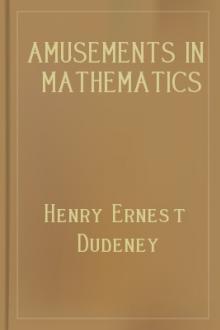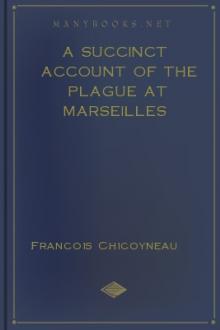Amusements in Mathematics, Henry Ernest Dudeney [books to read to be successful txt] 📗

- Author: Henry Ernest Dudeney
- Performer: 0486204731
Book online «Amusements in Mathematics, Henry Ernest Dudeney [books to read to be successful txt] 📗». Author Henry Ernest Dudeney

Here is a table of the results:—
I have not attempted the task of enumerating the ways of dividing a board 8x8—that is, an ordinary chessboard. Whatever the method adopted, the solution would entail considerable labour.
289.—LIONS AND CROWNS.—solution

Here is the solution. It will be seen that each of the four pieces (after making the cuts along the thick lines) is of exactly the same size and shape, and that each piece contains a lion and a crown. Two of the pieces are shaded so as to make the solution quite clear to the eye.
290.—BOARDS WITH AN ODD NUMBER OF SQUARES.—solution
There are fifteen different ways of cutting the 5x5 board (with the central square removed) into two pieces of the same size and shape. Limitations of space will not allow me to give diagrams of all these, but I will enable the reader to draw them all out for himself without the slightest difficulty. At whatever point on the edge your cut enters, it must always end at a point on the edge, exactly opposite in a line through the centre of the square. Thus, if you enter at point 1 (see Fig. 1) at the top, you must leave at point 1 at the bottom. Now, 1 and 2 are the only two really different points of entry; if we use any others they will simply produce similar solutions. The directions of the cuts in the following fifteen

solutions are indicated by the numbers on the diagram. The duplication of the numbers can lead to no confusion, since every successive number is contiguous to the previous one. But whichever direction you take from the top downwards you must repeat from the bottom upwards, one direction being an exact reflection of the other.
It will be seen that the fourth direction (1, 4, 3, 7, 10, 6, 5, 9) produces the solution shown in Fig. 2. The thirteenth produces the solution given in propounding the puzzle, where the cut entered at the side instead of at the top. The pieces, however, will be of the same shape if turned over, which, as it was stated in the conditions, would not constitute a different solution.
291.—THE GRAND LAMA'S PROBLEM.—solution
The method of dividing the chessboard so that each of the four parts shall be of exactly the same size and shape, and contain one of the gems, is shown in the diagram. The method of shading the squares is adopted to make the shape of the pieces clear to the eye. Two of the pieces are shaded and two left white.
The reader may find it interesting to compare this puzzle with that of the "Weaver" (No. 14, Canterbury Puzzles).

292.—THE ABBOT'S WINDOW.—solution
The man who was "learned in strange mysteries" pointed out to Father John that the orders of the Lord Abbot of St. Edmondsbury might be easily carried out by blocking up twelve of the lights in the window as shown by the dark squares in the following sketch:—

Father John held that the four corners should also be darkened, but the sage explained that it was desired to obstruct no more light than was absolutely necessary, and he said, anticipating Lord Dundreary, "A single pane can no more be in a line with itself than one bird can go into a corner and flock in solitude. The Abbot's condition was that no diagonal lines should contain an odd number of lights."
Now, when the holy man saw what had been done he was well pleased, and said, "Truly, Father John, thou art a man of deep wisdom, in that thou hast done that which seemed impossible, and yet withal adorned our window with a device of the cross of St. Andrew, whose name I received from my godfathers and godmothers." Thereafter he slept well and arose refreshed. The window might be seen intact to-day in the monastery of St. Edmondsbury, if it existed, which, alas! the window does not.
293.—THE CHINESE CHESSBOARD.—solution

Eighteen is the maximum number of pieces. I give two solutions. The numbered diagram is so cut that the eighteenth piece has the largest area—eight squares—that is possible under the conditions. The second diagram was prepared under the added condition that no piece should contain more than five squares.
No. 74 in The Canterbury Puzzles shows how to cut the board into twelve pieces, all different, each containing five squares, with one square piece of four squares.
294.—THE CHESSBOARD SENTENCE.—solution

The pieces may be fitted together, as shown in the illustration, to form a perfect chessboard.
295.—THE EIGHT ROOKS.—solution
Obviously there must be a rook in every row and every column. Starting with the top row, it is clear that we may put our first rook on any one of eight different squares. Wherever it is placed, we have the option of seven squares for the second rook in the second row. Then we have six squares from which to select the third row, five in the fourth, and so on. Therefore the number of our different ways must be 8 × 7 × 6 × 5 × 4 × 3 × 2 × 1 = 40,320 (that is 8!), which is the correct answer.
How many ways there are if mere reversals and reflections are not counted as different has not yet been determined; it is a difficult problem. But this point, on a smaller square, is considered in the next puzzle.
296.—THE FOUR LIONS.—solution
There are only seven different ways under the conditions. They are as follows: 1 2 3 4, 1 2 4 3, 1 3 2 4, 1 3 4 2, 1 4 3 2, 2 1 4 3, 2 4 1 3. Taking the last example, this notation means that we place a lion in the second square of first row, fourth square of second row, first square of third row, and third square of fourth row. The first example is, of course, the one we gave when setting the puzzle.
297.—BISHOPS—UNGUARDED.—solution

This cannot be done with fewer bishops than eight, and the simplest solution is to place the bishops in line along the fourth or fifth row of the board (see diagram). But it will be noticed that no bishop is here guarded by another, so we consider that point in the next puzzle.
298.—BISHOPS—GUARDED.—solution

This puzzle is quite easy if you first of all give it a little thought. You need only consider squares of one colour, for whatever can be done in the case of the white squares can always be repeated on the black, and they are here quite independent of one another. This equality, of course, is in consequence of the fact that the number of squares on an ordinary chessboard, sixty-four, is an even number. If a square chequered board has an odd number of squares, then there will always be one more square of one colour than of the other.
Ten bishops are necessary in order that every square shall be attacked and every bishop guarded by another bishop. I give one way of arranging them in the diagram. It will be noticed that the two central bishops in the group of six on the left-hand side of the board serve no purpose, except to protect those bishops that are on adjoining squares. Another solution would therefore be obtained by simply raising the upper one of these one square and placing the other a square lower down.
299.—BISHOPS IN CONVOCATION.—solution
The fourteen bishops may be placed in 256 different ways. But every bishop must always be placed on one of the sides of the board—that is, somewhere on a row or file on the extreme edge. The puzzle, therefore, consists in counting the number of different ways that we can arrange the fourteen round the edge of the board without attack. This is not a difficult matter. On a chessboard of n2 squares 2n - 2 bishops (the maximum number) may always be placed in 2(n) ways without attacking. On an ordinary chessboard n would be 8; therefore 14 bishops may be placed in 256 different ways. It is rather curious that the general result should come out in so simple a form.
300.—THE EIGHT QUEENS.—solution

The solution to this puzzle is shown in the diagram. It will be found that no queen attacks another, and also that no three queens are in a straight line in any oblique direction. This is the only arrangement out of the twelve fundamentally different ways of placing eight queens without attack that fulfils the last condition.
301.—THE EIGHT STARS.—solution
The solution of this puzzle is shown in the first diagram. It is the only possible solution within the conditions stated. But if one of the eight stars had not already been placed as shown, there would then have been eight ways of arranging the stars according to this scheme, if we count reversals and reflections as different. If you turn this page round so that each side is in turn at the bottom, you will get the four reversals; and if you reflect each of these in a mirror, you will get the four reflections. These are, therefore, merely eight aspects of one "fundamental solution." But without that first star being so placed, there is another fundamental solution, as shown in the second diagram. But this arrangement being in a way symmetrical, only produces four different aspects by reversal and reflection.

302.—A PROBLEM IN MOSAICS.—solution

The diagram shows how the tiles may be rearranged. As before, one yellow and one purple tile are dispensed with. I will here point out that in the previous arrangement the yellow and purple tiles in the seventh row might have changed places, but no other arrangement was possible.
303.—UNDER THE VEIL.—solution
Some schemes give more diagonal readings of four letters than others, and we are at first tempted to favour these; but this is a false scent, because what you appear to gain in this





Comments (0)